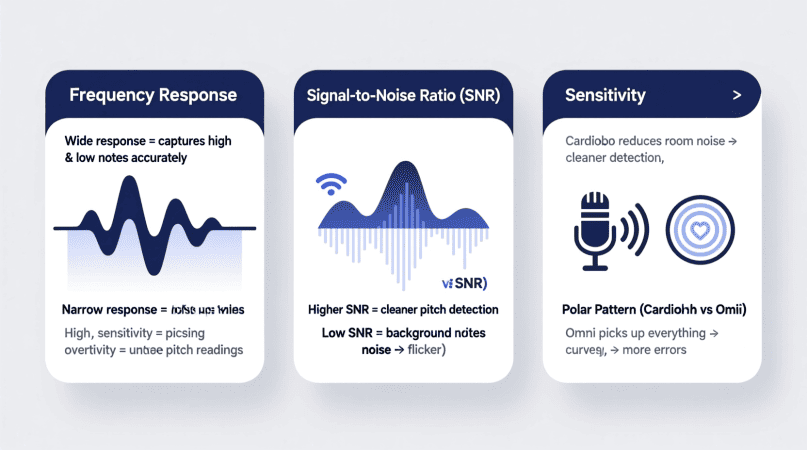
Ever noticed your pitch detector giving jumpy or inaccurate results? Often, the issue isn’t the software—it’s the microphone. The mic is the first step in the signal chain, and if it delivers a distorted, noisy, or incomplete signal, your pitch detector will struggle to lock onto the right frequency.
Let’s break down why microphone quality matters and how to choose or use one that helps you get stable, accurate readings.
Why Microphone Quality Matters for Pitch Detection
Pitch detection algorithms need a clear signal to identify the fundamental frequency. A poor-quality mic can create problems that make readings unstable or incorrect:
1. Frequency Response
- A good mic captures both the fundamental and overtones.
- Cheaper mics may roll off low or high frequencies, making the detector miss the real pitch and lock onto a harmonic instead.
- Example: a laptop mic might show an octave above your actual note because it can’t capture the low fundamental.
2. Sensitivity and Noise
- High self-noise adds hiss and hum, confusing the algorithm.
- Low sensitivity can bury your voice or instrument in the noise floor.
- A sensitive mic with low noise floor ensures the detector sees the pitch clearly, not random interference.
3. Directionality and Placement
- Omnidirectional mics pick up everything, including room reflections and background sounds.
- Cardioid mics focus on the direct source, improving signal clarity.
- Placement matters: too close = distortion; too far = weak, unstable readings.
4. Dynamic Range and Clipping
- A mic with limited headroom clips when you play or sing loudly, flattening waveforms.
- Pitch detectors then struggle to interpret the signal.
- Wider dynamic range keeps the sound natural, leading to more accurate detection.
5. Digital Conversion and Latency
- Built-in or low-cost USB mics may use low sample rates.
- Poor digital conversion causes jitter, latency, or unstable tracking.
- High-quality mics (with good interfaces) provide consistent sampling for smoother pitch detection.
Want to see the difference? Try the note to frequency converter with different mics and compare results yourself.
Mic Types Compared for Pitch Accuracy
| Mic Type | Pros | Cons |
|---|---|---|
| Condenser | Flat response, sensitive, accurate | Needs phantom power, delicate |
| Dynamic | Durable, handles loud volumes | Less detail in highs and lows |
| Built-in / Cheap | Convenient, low cost | Limited response, high noise floor |
How to Improve Pitch Detection Accuracy
- Use a mic with a flat frequency response for clear capture.
- Reduce room noise with directional pickup and good placement.
- Adjust gain to avoid clipping while keeping signal strong.
- Test different setups with our real-time pitch detection tool and compare how mics affect stability.
- If you’re training your voice, the voice pitch analyzer online gives detailed feedback and helps identify when mic quality is affecting readings.
FAQs
Q: Can I use my laptop mic for pitch detection?
Yes, but expect unstable results—it often misses the fundamental frequency.
Q: Does a condenser mic improve pitch accuracy?
Absolutely. Condensers capture more detail and give your detector a clearer signal.
Q: Why does my tuner show octave jumps?
Often because the mic can’t pick up the low fundamental, so it locks onto a harmonic.
Q: Does mic placement affect pitch detection?
Yes. Being too close distorts; too far weakens the signal. Balanced placement is key.
Pitch Detector is a project by Ornella, blending audio engineering and web technology to deliver precise, real-time pitch detection through your browser. Designed for musicians, producers, and learners who want fast, accurate tuning without installing any software.
